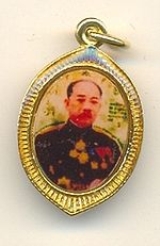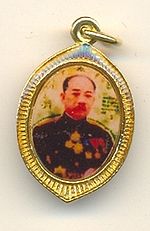
Phetsarath Rattanavongsa
Encyclopedia

Prime Minister of Laos
The Prime Minister of Laos is the head of government of the People's Democratic Republic of Laos.-Prime Ministers:-Trivia:Between December 1959 to December 1960, Laos had 6 different Prime Ministers, after being ousted by 6 different political coups....
of Laos
Laos
Laos Lao: ສາທາລະນະລັດ ປະຊາທິປະໄຕ ປະຊາຊົນລາວ Sathalanalat Paxathipatai Paxaxon Lao, officially the Lao People's Democratic Republic, is a landlocked country in Southeast Asia, bordered by Burma and China to the northwest, Vietnam to the east, Cambodia to the south and Thailand to the west...
from 1942 to 1945, and was the first and last vice-king of the Kingdom of Laos.
Early life
Phetsarath was born on 19 January 1890 in Luang PrabangLuang Prabang
Luang Prabang, or Louangphrabang , is a city located in north central Laos, where the Nam Khan river meets the Mekong River about north of Vientiane. It is the capital of Luang Prabang Province...
, the second son of Oupahat Bounkhong
Bounkhong
Prince Bounkhong, the son of Prince Souvanna Phomma, was the last uparaja of Luang Phrabang. He was granted the title of Chao Ratsaphakhinay in 1884. From 1911 to 1920, he was a member of the Government Council of French Indochina....
and his second wife, Princess Thongsy. One of his younger brothers was Souvanna Phouma
Souvanna Phouma
Prince Souvanna Phouma was the leader of the neutralist faction and prime minister of the Kingdom of Laos several times, from 1951–1952, 1956–1958, 1960 and 1962-1975.-Early life:...
. Bounkong's eleventh wife was the mother of Souphanouvong
Souphanouvong
Prince Souphanouvong was, along with his half-brother Prince Souvanna Phouma and Prince Boun Oum of Champasak, one of the “Three Princes” who represented respectively the communist , neutralist, and royalist political factions in Laos...
. Phetsarath went to study at the colonial Lycee Chasseloup Laubat in Saigon
Ho Chi Minh City
Ho Chi Minh City , formerly named Saigon is the largest city in Vietnam...
and continued on in 1905 to the Lycée Montaigne
Lycée Montaigne
The Lycée Montaigne is a famous French public secondary school. It is located in the 6th arrondissement of Paris, near the Jardin du Luxembourg, and was founded in the 1880s....
and to the École coloniale
École nationale de la France d'Outre-mer
The École Nationale de la France d'Outre-Mer was a French grande école, providing training for future colonial administrators...
in Paris. He returned to Laos in 1912, married Princess Nhin Kham Venne in 1913, and started working as an interpreter for his father.
Government service: 1914-1941
In 1914, he became a clerk at the Office of the French governor in Vientiane. Two years later he was promoted to assistant secretary to the French governor. In 1919 he received the title of Somdeth Chao Ratsaphakhinay, a title held by his father and one of the highest ranks in the country. That same year he was named Director of Indigenous Affairs of Laos operating under the French governor.As the country's last oupahat, he became a leading figure of modern Laos. He established the system of ranks and titles of the civil service, promotion and pension plans, and created a Lao consultative assembly, reorganized the king's Advisory Council. Phetsarath reorganized the administrative system of the Buddhist clergy, and established a system of schools for educating monks in Pali. He created the Institute of Law and Administration to train entry level officers (Samien) who would then move up the ladder as Phouxouei, Chao Meuang, and Chao Khoueng successively. He set up rules to reward, reassign, and promote deserving civil servants, and created the judicial system, including civil and penal codes.
Lao Issara: 1941-1957
Phetsarath played a dominant role in Lao politics before and after the Japanese occupation. He was the leader of the Lao IssaraLao Issara
The Lao Issara was an anti-French, non-communist nationalist movement formed in 1945 by Prince Phetsarath. This short-lived movement emerged after the Japanese defeat in World War II and became the government of Laos before the return of the French. It aimed to prevent the French from restoring...
movement.
He left for Thailand
Thailand
Thailand , officially the Kingdom of Thailand , formerly known as Siam , is a country located at the centre of the Indochina peninsula and Southeast Asia. It is bordered to the north by Burma and Laos, to the east by Laos and Cambodia, to the south by the Gulf of Thailand and Malaysia, and to the...
in 1946 to head the Lao Issara government-in-exile.
In 1944 he sent Kathanong Souvannakhily, a brigade officer, to attack Thailand, but he went missing in action. The attack was subsequently halted.
Return: 1957-1959
In March 1957, he returned to VientianeVientiane
-Geography:Vientiane is situated on a bend of the Mekong river, which forms the border with Thailand at this point.-Climate:Vientiane features a tropical wet and dry climate with a distinct monsoon season and a dry season. Vientiane’s dry season spans from November through March. April marks the...
where he received a wild welcome. On 10 April 1957, he travelled to Luang Prabang
Luang Prabang
Luang Prabang, or Louangphrabang , is a city located in north central Laos, where the Nam Khan river meets the Mekong River about north of Vientiane. It is the capital of Luang Prabang Province...
by car and was received by an enormous crowd of citizens, government officials, and members of the police and the army. On 16 April he paid a courtesy call to King Sisavang Vong
Sisavang Vong
Sisavang Phoulivong , was king of Kingdom of Luang Phrabang and later Kingdom of Laos from 28 April 1904 until his death on 20 October 1959.-Early life:...
and was given back his old title of Oupahat of the Kingdom of Laos
Kingdom of Laos
The Kingdom of Laos was a sovereign state from 1953 until December 1975, when Pathet Lao overthrew the government and created the Lao People's Democratic Republic. Given self-rule in 1949 as part of a federation with the rest of French Indochina, the 1953 Franco-Lao Treaty finally established a...
. In December 1957 he visited Samneua and Phongsaly where Souphanouvong
Souphanouvong
Prince Souphanouvong was, along with his half-brother Prince Souvanna Phouma and Prince Boun Oum of Champasak, one of the “Three Princes” who represented respectively the communist , neutralist, and royalist political factions in Laos...
symbolically offered the return of the Pathet Lao
Pathet Lao
The Pathet Lao was a communist political movement and organization in Laos, formed in the mid-20th century. The group was ultimately successful in assuming political power after the Laotian Civil War. The Pathet Lao were always closely associated with Vietnamese communists...
's two regrouping provinces to the Kingdom of Laos.
He was offered an official government residence in Vientiane
Vientiane
-Geography:Vientiane is situated on a bend of the Mekong river, which forms the border with Thailand at this point.-Climate:Vientiane features a tropical wet and dry climate with a distinct monsoon season and a dry season. Vientiane’s dry season spans from November through March. April marks the...
, but preferred to stay in his villa, Xieng Keo
Xieng Keo
Xieng Keo is a former residence of Prince Phetsarath in Louang Phrabang, Laos. In January 2002, it changed into a hotel. The location was originally chosen by the prince for its stunning views of the Mekong River and the surrounding mountain peaks....
, in Luang Prabang
Luang Prabang
Luang Prabang, or Louangphrabang , is a city located in north central Laos, where the Nam Khan river meets the Mekong River about north of Vientiane. It is the capital of Luang Prabang Province...
with his Thai consort, Mom Aphiphorn. In early October 1959 the Phoui Sananikone
Phoui Sananikone
Phoui Sananikone was Prime Minister of the Kingdom of Laos on two occasions in 1950 to 1951 and again from 1958 to 1959, and also served as Foreign Minister on multiple occasions.-Prime Ministership:...
Government decided to use Phetsarath's official residence in Vientiane
Vientiane
-Geography:Vientiane is situated on a bend of the Mekong river, which forms the border with Thailand at this point.-Climate:Vientiane features a tropical wet and dry climate with a distinct monsoon season and a dry season. Vientiane’s dry season spans from November through March. April marks the...
as the new prime minister's office. They vacated the building and shipped his personal belongings by boat to Luang Prabang
Luang Prabang
Luang Prabang, or Louangphrabang , is a city located in north central Laos, where the Nam Khan river meets the Mekong River about north of Vientiane. It is the capital of Luang Prabang Province...
, which upset him immensely. On 14 October 1959 Phetsarath was taken ill to the hospital, suffering from a severe brain hemorrhage. A French doctor operated on him, but it was already too late. He never regained conscience and he died at the age of 69.
In part because of his popularity and in part because of his perceived saksit
Saksit
Saksit is a term for supernatural powers used in Laos and Thailand. The belief in such powers originates in the animistic religion which existed before the Buddhism was adopted and merged into the traditional religion.-External links:*...
power, many Lao people
Lao people
The Lao are an ethnic subgroup of Tai/Dai in Southeast Asia.-Names:The etymology of the word Lao is uncertain, although it may be related to tribes known as the Ai Lao who appear in Han Dynasty records in China and Vietnam as a people of what is now Yunan Province...
hang his picture in their homes.

